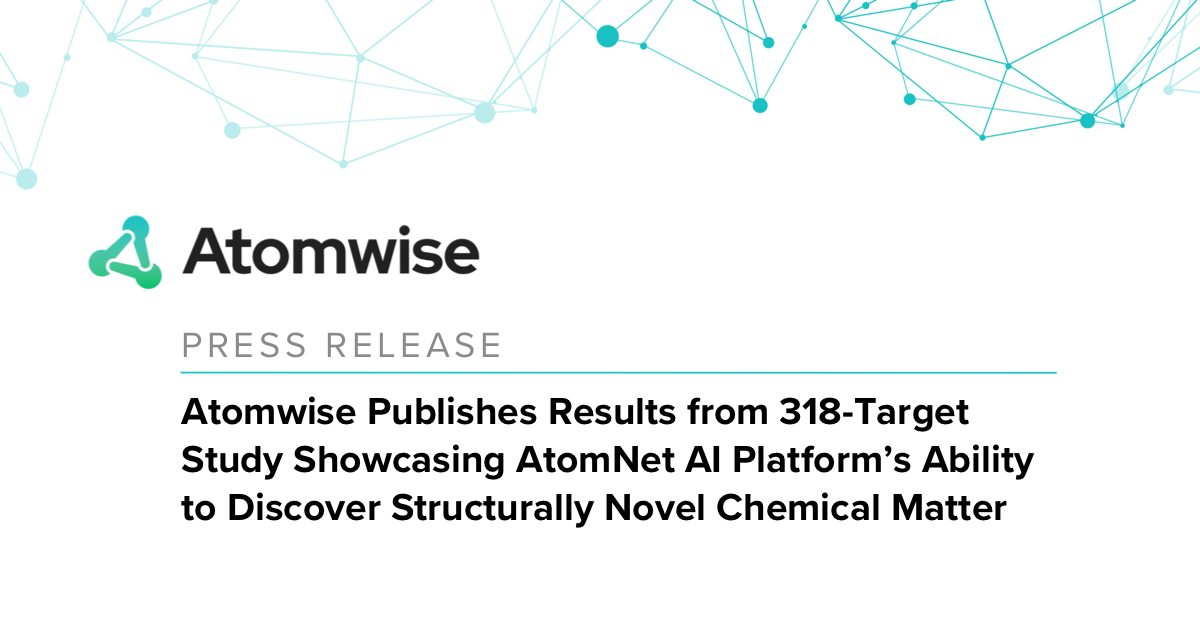San Francisco, CA - April 2, 2024 – Atomwise announced today results from the AIMS (Artificial Intelligence Molecular Screen) initiative that establish the AtomNet AI Platform as a viable alternative to high-throughput screening (HTS) and verify its ability to consistently discover structurally novel chemical matter. The landmark study applied AtomNet to 318 targets through collaborations with over 250 academic labs across 30 countries, representing the largest and most comprehensive virtual HTS campaign reported to date.
In a paper published in Nature Scientific Reports, AtomNet successfully identified structurally novel hits for 235 of 318 targets evaluated, representing a significant improvement in hit success rate over traditional HTS. AtomNet demonstrated consistently high hit rates across all target classes, which covered a wide breadth of protein classes relevant across major therapeutic areas, confirming the broad applicability of the AI platform. AtomNet also showed a remarkable ability to discover novel chemical matter, averaging over seven structurally distinct bioactive compounds per target.
Developed by Atomwise, AtomNet was the first deep neural network designed to predict the bioactivity of small molecules in structure-based drug discovery. Conventional HTS cannot evaluate over 99% of commercially available molecules, which increasingly come from synthesis-on-demand libraries. In contrast, AtomNet’s virtual HTS approach searches an expanding chemical library of more than 15 quadrillion synthesizable compounds to accurately find hits that deviate from any known binders, enabling rapid discovery from vast, unexplored chemical space.
“We need new technologies for new targets. As the pharma industry increasingly moves to tackle harder and harder disease biology, we need new molecules that can address these challenges,” said Mike Varney, former Executive Vice President and Head of Genentech Research and Early Development, and Atomwise Board Member. “For a generation, the pharma industry has largely relied on a single source – HTS – to identify new bioactive compounds. Any new approach needs to demonstrate applicability and robustness across the entire proteome. It is exciting to see Atomwise demonstrate their successes on such a broad range of disease targets.”
“The ability of AtomNet to consistently identify novel bioactive chemical compounds solves a fundamental challenge and inefficiency with current small molecule drug discovery,” said Gavin Hirst, Chief Scientific Officer of Atomwise. “Medicinal chemists always want new scaffolds to work on. A new scaffold lets you make progress and potentially unlocks different selectivity, pharmacokinetics, or pharmacodynamics. Access to new scaffolds increases the probability that the developed molecule will meaningfully differentiate in the clinic.”
For most projects, the AtomNet training data contained no active molecules for the target protein or any close homologs. As a result, discovered hits often represent first-in-class binders for newly discovered or difficult-to-target proteins. Examples from the AIMS initiative include the first reducer for Miro1, a new target in Parkinson’s disease, the first inhibitors for OTUD7A and OTUD7B, challenging deubiquitinase targets for solid and hematological tumors, and small molecule inhibitors for CTLA-4, a well-established oncology target.
“Generally the predictive power of virtual screening platforms has been extremely limited,” said Prof. Gregory Bowman of the University of Pennsylvania, who used AtomNet to uncover a cryptic site for phosphatase PPM1D, a therapeutic target in oncology. “Results of the AIMS study show that AtomNet has a high success rate in finding hits for traditionally challenging biology, like allosteric or protein-protein interactions. This noteworthy ability opens the door for many targets that have been previously deemed intractable.”
“AtomNet enabled us to discover highly selective inhibitors for two emerging targets with potential applicability across a range of cancers, but lacking known non-covalent binders,” said Pengda Liu, Ph.D., assistant professor in the Department of Biochemistry and Biophysics at UNC-Chapel Hill. “Despite the novelty and challenge of these targets, the compounds AtomNet predicted are potent to the point where we are currently moving forward with medicinal chemistry efforts. It is clear that AI approaches like AtomNet can fundamentally change the way we think about what is possible, and I have no doubt that it will play a critical role in future drug development.”
“We designed AtomNet to be able to extrapolate molecular learnings across targets and actively predict activity for new and challenging targets,” said Abraham Heifets, CEO, Atomwise. “Historically, one of the major challenges for AI-driven discovery has been a need for pre-existing, on-target ligand data to accurately predict activity, narrowing AI’s applicability. We’ve shown for the first time that AtomNet does not require any target-specific training data and can be applied to virtually any target, even those that have been considered undruggable.”
“Comprehensively testing the capabilities of AtomNet across such a wide range of targets clearly demonstrates the unprecedented accuracy of the platform to identify novel drug-like scaffolds,” says Izhar Wallach, who led the AIMS initiative and is Chief Technology Officer of Atomwise. “We are hugely thankful for the hundreds of talented researchers across the world who made this collaboration possible.”
Atomwise plans to file an IND application this year for its lead candidate, a novel allosteric TYK2 inhibitor with first-in-class and best-in-class potential, which was discovered using AtomNet. The company’s vision is to invent a better way to discover and develop new medicines to help patients. Our belief is structurally novel chemical matter increases the likelihood of developing first-in-class and best-in-class medicines that have the potential to transform patient care.
About Atomwise
Atomwise is a TechBio company leveraging AI/ML to revolutionize small molecule drug discovery. The Atomwise team invented the use of deep learning for structure-based drug design, a core technology of Atomwise’s best-in-class AI discovery and optimization engine, which is differentiated by its ability to find and optimize novel chemical matter. Atomwise has extensively verified its discovery engine, having demonstrated the ability to find compounds with therapeutic potential hundreds of times across a wide variety of protein types and multiple “hard to drug” targets. Atomwise is advancing a proprietary pipeline of small-molecule drug candidates.
Our vision is to invent a better way to discover and develop new medicines to help patients. Learn more at atomwise.com or follow @AtomwiseInc.
Contacts
Kimberly Ha
KKH Advisors
[email protected]
917-291-5744

